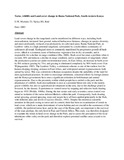Tsetse, wildlife and Land-cover change in Ruma National Park, South-western Kenya

View/
Date
2003Author
G.W, Muriuki
TJ, Njoka
RS, Reid
Type
ArticleLanguage
enMetadata
Show full item recordAbstract
Land-cover change in the rangelands can be manifested in different ways, including bush
encroachment, increased bare ground, reduced herbaceous biomass, changes in species diversity, and more profoundly, reduced crop productivity in cultivated areas. Ruma National Park, in Lambwe valley is a high potential rangeland, surounded by a multi-ethnic community of cultivators all round. Ecological stress is commonlv manifested by progressive growth of bush cover, which is a common cause of herbaceous vegetation loss in dry savannahs, and is responsible for a decline in range condition (Oba,
2000). Bush cover becomes a problem when it exceeds 30% and induces a decline in range condition, and is symptomatic of rangelands where the production systems are under environmental stress. In East Africa, an increase in bush cover by l0% reduces grazing by 7%o, and grazing is eliminated completely by 90% bush cover (Van
Wijingaarden, 1985). The Lambwe Valley, a settlement scheme, is one of the earliest foci for human sleeping sleeping sickness in East Africa, and widespread animal
trypanosomosis both spread by tsetse. This was a deterrent to human occupation despite the suitability of the land for most agriculrural practices. In order to encourage seftlement, concerted efforts by foreign donors and the Kenya government have seen a significant reduction in both human and animal trypanosomosis. Due to the proximity within which people have settled to the park and the abundance of wildlife, bush encroachment
is seen as a potential threat not only to the mainly grazer wildlife, but also to agricultural
development in the area, due to the challenge posed to livestock by the disease. Experiments to control tsetse by trapping and selective bush clearing began in 1935 (Wellde, 1989a). During the late sixties and early seventies, tsetse control was aimed at isolation of the tsetse-infested thickets within the park. Consequently, bush clearing
aerial spraying, ground spraying, traps and targets have all been applied principally in the
Park, with different aims and levels of success
(Davies, 1993). Despite the enormous scientific attention in this park owing to tsetse and its control, there has been no examination of trends in land cover, which are a main determinant of tsetse habitat,and are crucial in the sustenance of the wildlife,
the preferred tsetse host, and in the case of the Ruma park, are important to the survival of the roan antelope, the only herd in East and Central Africa. This study was therefore designed to examine the trends in land-cover change in the Park, and to assess the perception of the local inhabitants ofthe valley on the park and therefore explore potential conflict areas crucial to its survival.
Citation
J. Hum. Ecol., 14(4): 229-235 (2003)Publisher
Department Of Land Resource Management and Agricultural Technology, University of Nairobi
